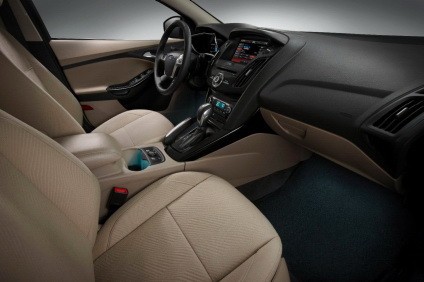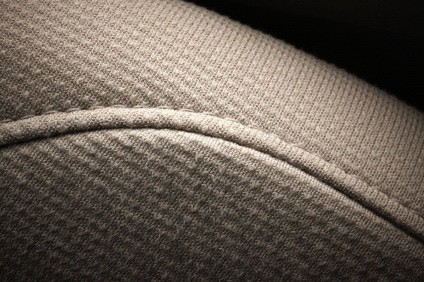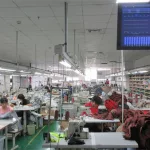 It is not only in the electric cars of tomorrow that the interiors are set to become feel-good zones with a host of different innovative features. Designers now have, at their disposal, new kinds of textiles and fibre-based lightweight composites that emit light and heat, conduct electricity and even have sensory capabilities. These developments – some of them still ‘hot from the laboratory’ – are meeting with interest from manufacturers of cars, lorries and buses alike. Often still in the research phase and, hence, hardly beyond the prototype stage, never mind in regular production and available for the mass market, they recommend themselves for applications in air, rail and sea travel because of their fantastically useful properties.
It is not only in the electric cars of tomorrow that the interiors are set to become feel-good zones with a host of different innovative features. Designers now have, at their disposal, new kinds of textiles and fibre-based lightweight composites that emit light and heat, conduct electricity and even have sensory capabilities. These developments – some of them still ‘hot from the laboratory’ – are meeting with interest from manufacturers of cars, lorries and buses alike. Often still in the research phase and, hence, hardly beyond the prototype stage, never mind in regular production and available for the mass market, they recommend themselves for applications in air, rail and sea travel because of their fantastically useful properties.
Since the automotive and air-travel industries, in particular, are drivers of textile technologies, appropriate new developments will soon also be finding their way into representative offices, banks and not a few homes too: textile elements with alternate positive mood lighting, entrances to buildings with luminescent textile signs, curtains and woven wall components with lighting and air-conditioning functions.
Techtextil 2013 to showcase scenarios of the future

 Although the automobile industry hardly ever shows its hand – in this case, the interior equipment of tomorrow – before model launches, the corresponding trends for interiors will already be clear in outline at the next Techtextil from 11 to 13 June 2013 in Frankfurt am Main. At the same time, research projects, workshops and communiqués from textile and leather research institutes centrally involved with ‘smart’ or ‘intelligent’ textiles, point in the direction of possible future scenarios for car cockpits. These also include, amongst others, Techtextil exhibitors such as The Textile Research Institute Thuringia-Vogtland (Textilforschungsinstitut Thüringen-Vogtland – TITV) from Greiz, The Institute for Textile and Process Technology (Institut für Textil- und Verfahrenstechnik – ITV) in Denkendorf near Stuttgart and the Research Institute for Leather and Plastic Sheeting (Forschungsinstitut für Leder und Kunststoffbahnen – FILK), based in Freiberg/Saxony.
Although the automobile industry hardly ever shows its hand – in this case, the interior equipment of tomorrow – before model launches, the corresponding trends for interiors will already be clear in outline at the next Techtextil from 11 to 13 June 2013 in Frankfurt am Main. At the same time, research projects, workshops and communiqués from textile and leather research institutes centrally involved with ‘smart’ or ‘intelligent’ textiles, point in the direction of possible future scenarios for car cockpits. These also include, amongst others, Techtextil exhibitors such as The Textile Research Institute Thuringia-Vogtland (Textilforschungsinstitut Thüringen-Vogtland – TITV) from Greiz, The Institute for Textile and Process Technology (Institut für Textil- und Verfahrenstechnik – ITV) in Denkendorf near Stuttgart and the Research Institute for Leather and Plastic Sheeting (Forschungsinstitut für Leder und Kunststoffbahnen – FILK), based in Freiberg/Saxony.
What can car drivers and other users expect to find between car carpets and headlinings over the next few years? Certainly a great deal of ergonomics, using sustainable and naturally effective materials and tactile surfaces that make it possible to create individuality of design in cars as well as elsewhere. The key focus here: cockpit lighting, adjustable mood lighting and touchpads for the driver, all tailored to the customers wishes. Korean manufacturers, Kia, have already risked a first step in the direction of light-emitting textiles in their city car ‘Soul’. In two versions of the model, a luminescent (unpowered, light-emitting) inscription with the word ‘Soul’ has been woven into the upper part of the seat back.
Five interior areas of application for ‘smart’ textiles
Meanwhile, German textile research’s dialogue with the automobile and motor-vehicle industry has moved on considerably; Sabine Gimpel, Head of Marketing at the TITV, identifies several areas of application for smart textiles in car interiors, from the point of view of her research institution which specialises in textile micro-systems technology. Looking at electrically powered vehicles then this might, for instance, be new kinds of seat heaters. “Up to now, they have been deep in the squab. But there, the covering material acts as insulation. With new materials, it is possible to build the heating elements into the seat covers, the arm rest surfaces or the door panels and thus design the seat construction to be much lighter.”
 Ms. Gimpel sees further opportunities in applications using sensitive textile panels for, say, determining what is on a seat squab (in a crash, if, say, there is only a handbag on the passenger seat, then the airbag won’t deploy) and for monitoring bio-signals by means of textile sensor technology to check on the driver’s current state of health. Ms. Gimpel, an expert in this field, is convinced that light-emitting textiles with woven LED threads and glare-free light sources, as well as woven electroluminescent surfaces, will meet the need for both orientation and ambience in cars of the future. In Greiz, continues the Head of Marketing, there is a technology that is just now reaching the operational stage of industrial – and hence cheap – manufacture of light-emitting textiles. With this technology, LEDs can be attached to conductive threads using an embroidering machine and the (soldered) contact then created. When this material is mass-produced, headlinings can be illuminated in a way that both saves energy and is individually tailored to the taste of the purchaser; so, too, can interior door panels.
Ms. Gimpel sees further opportunities in applications using sensitive textile panels for, say, determining what is on a seat squab (in a crash, if, say, there is only a handbag on the passenger seat, then the airbag won’t deploy) and for monitoring bio-signals by means of textile sensor technology to check on the driver’s current state of health. Ms. Gimpel, an expert in this field, is convinced that light-emitting textiles with woven LED threads and glare-free light sources, as well as woven electroluminescent surfaces, will meet the need for both orientation and ambience in cars of the future. In Greiz, continues the Head of Marketing, there is a technology that is just now reaching the operational stage of industrial – and hence cheap – manufacture of light-emitting textiles. With this technology, LEDs can be attached to conductive threads using an embroidering machine and the (soldered) contact then created. When this material is mass-produced, headlinings can be illuminated in a way that both saves energy and is individually tailored to the taste of the purchaser; so, too, can interior door panels.
Company network develops textile switches
At Techtextil, which sees itself both as a leading world trade fair and a driver of innovation at one and the same time, just on a dozen companies will be showcasing their new products for vehicle interiors. Exhibiting with us for the first time are two company networks, sponsored by the Federal Ministry of Economics and managed by Steffi Volland (Oelsnitz / Saxony): InoRetex and LanoTex – both represented on the joint service providers’ stand ‘Nord-Ost-Textil’ (North East Textiles). “We have just received the official go-ahead for the LanoTex pilot project ‘Integration of electronics’,” says the network co-ordinator with some pleasure. This secures the development of a textile touchpad for use in vehicle and aircraft seats until the end of 2014. The aim is to integrate sensor technology into seat and headrest covers that will, for instance, control the seating position, the LED lighting or digital multi-media functions. The embroidery companies from the area around Plauen will contribute their experience of the relevant technology to achieve this.
Adjustable feel-good colours for bus passengers
While we are on the subject of light-emitting textiles, the lighting laboratory at the The Institute for Textile and Process Technology (Institut für Textil- und Verfahrenstechnik – ITV), which has the lead role in the project, is researching and demonstrating the properties of new types of light-emitting fibres that they have manufactured themselves; properties that are largely unknown, other than to a specialist public. The materials can be produced in any desired shape or colour, and at the same time produce a powerful light source, either by emitting light themselves or by being back-lit with LEDs across a wide area and, if required, also with a sense of three-dimensionality. This laboratory, one might add, is where notions of active lighting in interiors for the big motor manufacturers first begin to take shape, using structured methods for generating ideas.
Even bus, train and tram manufacturers have beaten a path to the door of these textile researchers, since the possibility of visual effects with textiles, based on active and passive light-emitting threads may well give new directions to their mobility solutions of tomorrow. “We are pushing forward some exciting research for HGVs, buses and aircraft,” says Laboratory Director Christoph Riethmüller, referring to projects that are financed by industry. For example, under the heading of ’emotional lighting’, they are working on a new kind of lighting design that can be coordinated with the optimum comfortable temperature. In this way, the passengers’ subjectively differing perceptions of temperature can, to a large extent, be reduced to a common denominator by the effects of the lighting controls.
A specialist in the field of leather research, FILK Director, Prof. Dr. Michael Stoll, stresses the issue of weight reduction in the cabin interior through new combinations of materials, innovative seaming techniques, composite technologies and layering methods such as lightweight textile construction and organic electronics. When it comes to issues of feel / soft touch / and a sense of comfortable well-being, his team is continuing, on the one hand, to focus their attention on determining and objectively describing haptic parameters; on the other hand, their agenda consists of the targeted adjustment of haptic properties to produce pleasant sensations of touch using new kinds of surface structuring and layering techniques. On top of this, the Freiberg scientists are working on a passive cooling system for the seats to make them more comfortable to sit on. With a glance towards electric vehicles, they are also trying to create a defined level of air-permeability and/or circulation, with the help of optimised and cleverly combined materials, yet without, at the same time, affecting any other material properties.
Techtextil in Frankfurt next June, at which Research and Development will be just one of eleven product groups, is once again expecting some 25,000 visitors from about 100 countries. There are also five other trade fairs of the same name in the most important sales regions of the world: in 2013, trade fairs will be held in Anaheim / USA and Mumbai / India. Texprocess, Leading International Trade Fair for Processing Textile and Flexible Materials, will be held concurrently with Techtextil from 10 to 13 June 2013.
The Textile Research Institute Thuringia Vogtland e. V. (TITV Greiz)

